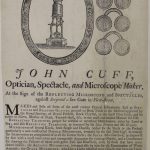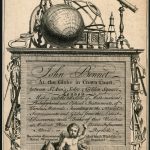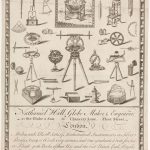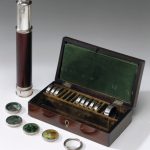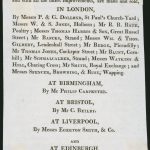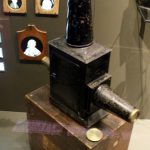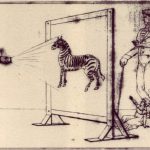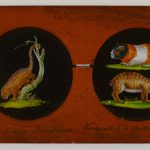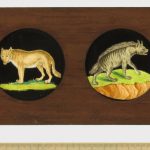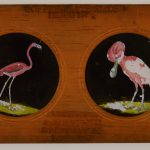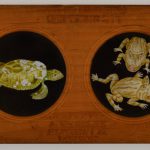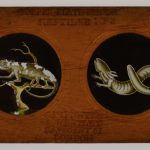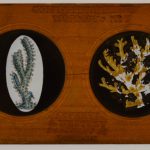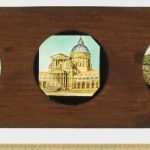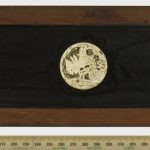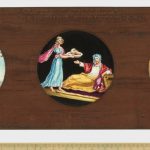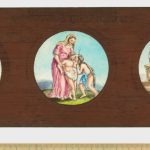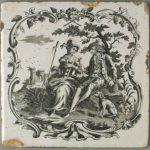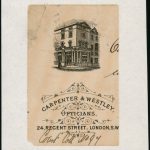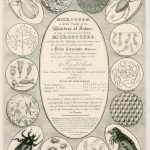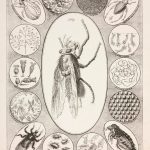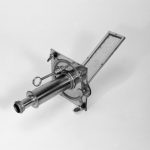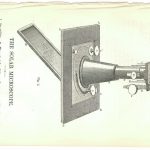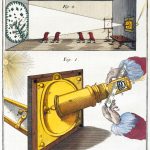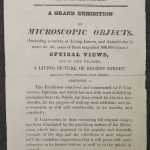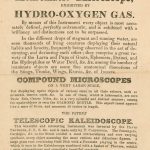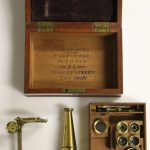Philip Carpenter and the convergence of science and entertainment in the early-nineteenth century instrument trade
Abstract
https://dx.doi.org/10.15180/170707/001This article will consider the alignment of scientific and media practice at the beginning of the nineteenth century. Over several decades after 1817 certain instrument makers began to specialise in the domestic entertainment market, transferring skills from optical instrument manufacture to the design of fashionable novelty devices. The instrument trade was expanding into a new middle-class market to exploit an increasing popular trade in optical novelties, exemplified by the 1817 Kaleidoscope craze and new interest among the middle classes for microscopes, telescopes, and magic lanterns. This paper will address this shift towards more popular uses of scientific instruments and optical toys. In particular it will address the involvement of the Birmingham and London optician Philip Carpenter in three popular media formats of the 1810s and 1820s — the 1817 patent Kaleidoscope, 1821 Improved Phantasmagoria Lantern and 1827 Microcosm.
Keywords
Carpenter & Westley, entertainment, exhibition, Kaleidoscope, magic lantern, nineteenth century, optical instruments, Philip Carpenter, retail, scientific instrument makers, solar microscope
Introduction
https://dx.doi.org/10.15180/This article uses a detailed case study to explore how the interaction between science and entertainment can emerge through analysis of the cultural history of specific artisans and artefacts. Philip Carpenter was one of many instrument makers that moved to capture a growing market for domestic instruments, selling microscopes, telescopes, looking-glasses and a range of devices for exhibiting entertaining spectacles. This paper will address three phases of Carpenter’s career: his involvement in the production of David Brewster’s 1817 Kaleidoscope; his 1821 Improved Phantasmagoria Lantern; and the 1827 Microcosm exhibition. For Carpenter, as with other instrument makers at the beginning of the nineteenth century, there was no clear separation between science and entertainment. The legacy of this disciplinary crossover would be the continued expansion of popular entertainments over the century. By the end of the nineteenth century optical instruments were among the most popular forms of entertainment in the home and for public exhibition. The scientific instrument trade was one significant precursor of this burgeoning market for projected spectacles and optical marvels. I will show that there is no distinction between scientific and entertainment instruments in Carpenter’s manufacturing and retail practice. His principle aim was to make money, so he utilised his skills as an optician to engage in whatever markets presented themselves. Carpenter sold microscopes as optical novelties and magic lanterns as educational devices. There was always some slippage between categories and he oriented much of his practice to take advantage of this. Engagement in multiple entertainment, experimental and professional markets was typical of instrument makers at this time, but it is rare to see this in such detail as I am to present here. Carpenter’s case offers a valuable contribution to our understanding of the instrument and media trades. Through a detailed study of his life and work in the 1810s and 1820s, I will show what practice he employs and what networks he exploits to navigate the changing economic landscape of the early-nineteenth century.
Carpenter began working as a manufacturing optician in Birmingham in 1808, specialising in spectacles and microscopes, before becoming manufacturer of Brewster’s Patent Kaleidoscope in 1817. This was wildly popular and became the first consumer media craze. Carpenter opened a retail shop in Birmingham around 1819 and released the Improved Phantasmagoria Lantern in 1821. This was one of the key consumer lanterns that helped support the expansion of lantern retail in the 1820s and 1830s. In 1826 he opened another at 24 Regent Street in Westminster, where he established an exhibition of microscopic views called the Microcosm. This became a popular addition to the range of attractions around Regent Street and made Carpenter quite famous. He died in 1833, to be succeeded by his sister Mary. In 1837, after shedding the Birmingham wing of the business to earlier foreman Robert Field, Mary took William Westley into partnership. Westley had been apprenticed to Carpenter from 1821 and became foreman after Field left to pursue business on his own. With the formalisation of their partnership, the Carpenter business became Carpenter & Westley, going on to become one of the most significant consumer media producers of the century.
Carpenter was among the most important drivers of the expansion of consumer media technologies in the 1810s and 1820s, where scientific instrument makers began to specialise in the popular and domestic markets, eventually shedding their positions as scientific practitioners entirely, to become manufacturers of optical media instruments. With the 1817 Kaleidoscope Philip Carpenter and David Brewster succeeded in creating a craze for a new novelty instrument. The Kaleidoscope was retailed as a must-have device and sold at a faster rate than most other instruments. The newness of the Kaleidoscope became something to exploit, and this worked to such an extent that contemporary sources talk of a ‘mania’ for the device (Correia, 2016, p 5; ‘Political Periscope’, 1818, p 503). Carpenter later repeated this approach to retail with the Improved Phantasmagoria Lantern and the solar microscope. Both took longstanding instruments and presented them as novelties to be consumed anew. Such was the success of Carpenter’s marketing that he has been credited with invention or innovation for aspects of both instruments (Mannoni, 2000, pp 289–290; Beattie, 2013, p 6; Heard, 2006, p 197; ‘Spirit of Discovery’, 1836, p 40; Timmins, 1866, p 534) despite having added only minor improvements. A description of the development and significance of the Kaleidoscope, the Phantasmagoria Lantern, and the Microcosm exhibition is given below.
The instrument makers
https://dx.doi.org/10.15180/170707/002Throughout the eighteenth century scientific instrument makers served several distinct markets: they produced precision instruments for scientists and experimental institutions; surveying instruments for building infrastructure and transport networks; navigational instruments for maritime transport and overseas trade; tradesmen’s tools for measuring or dividing; and luxury domestic instruments that conferred cultural prestige on curious amateurs (Morrison-Low, 2007, pp 249–283; Bedini, 1964, pp 3–13; Sorenson, 1995, p 264). After several hundred years of development, the instrument trade was extremely diversified. Few manufacturers produced only experimental instruments for scientists. This range of different markets was exploited to sustain consistent profits through separate income streams.
It was natural that skilled lens-grinders, as the optical instrument makers were, would turn their hand to any instrument that could be assembled using their skill-set, regardless of its field or application. If we consult the trade cards for different manufacturers we see a plethora of different instruments and devices. John Cuff of Fleet Street (see Figure 1) advertises reading glasses, refracting and reflecting telescopes, several different microscopes, barometers, thermometers and speaking trumpets. John Bennet of Crown Court (see Figure 2) advertises microscopes, telescopes, rules, globes, sundials, theodolites and compasses, among a jumble of other instruments. Nathaniel Hill of Chancery Lane (see Figure 3) advertises a similar range of professional and analytical instruments and announces that he ‘makes and sells all sorts of mathematical instruments in silver, ivory and wood, very curious and true graduated for sea or land, with books for their use and the best black-lead pencils’. Many of the items on offer would have been bought in for retail, but each maker would also have maximised their own manufacturing skills to produce all kinds of different instruments.
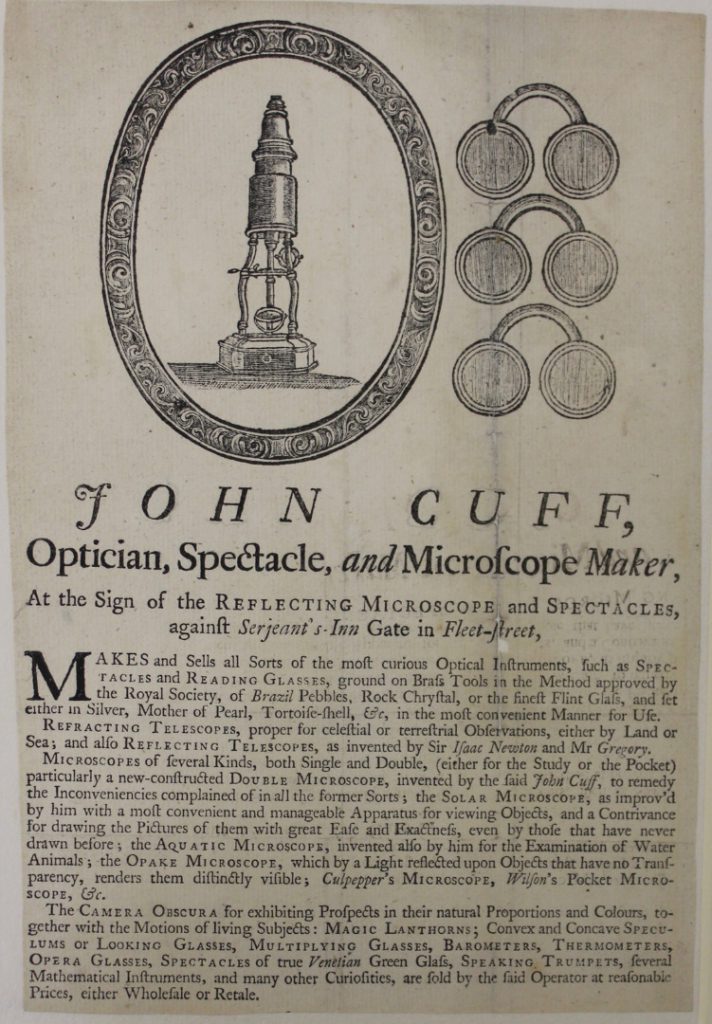
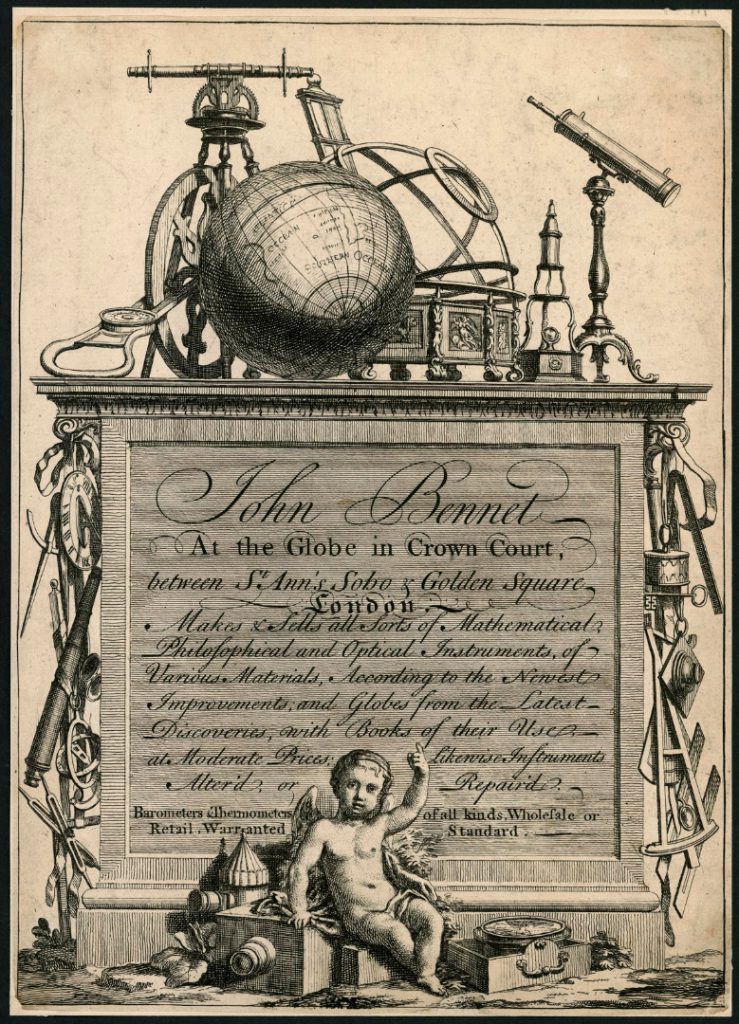
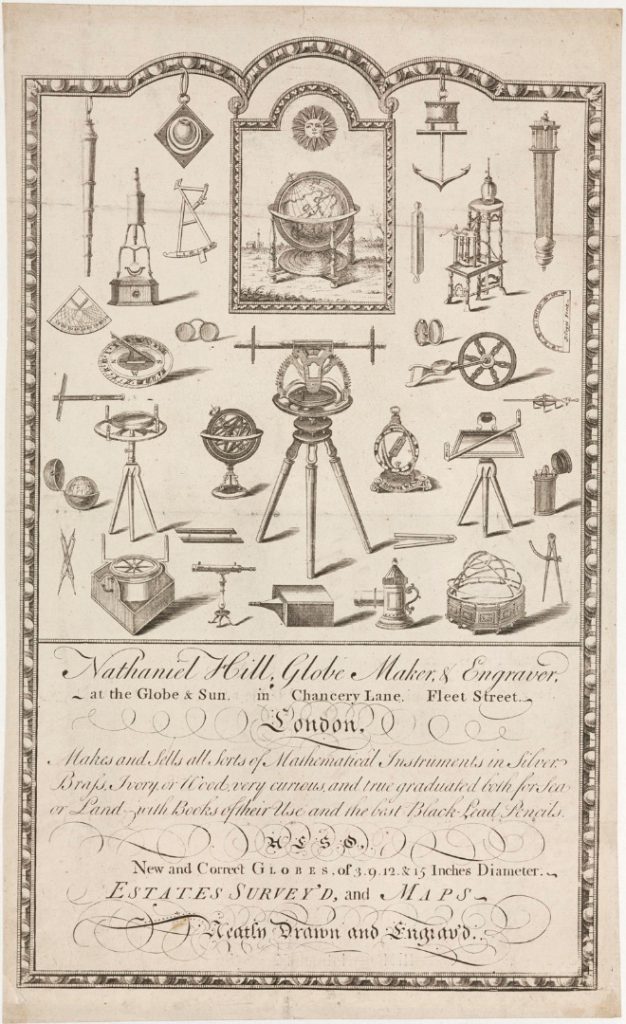
But these markets were not stable. At different times the relative importance of each would rise and fall and manufacturers would react through specialisation. Occasionally, a large precision contract would become available and several makers would scramble to claim the work. John Bird produced a large set of astronomical instruments for the Radcliffe Observatory in 1771 (Morrison-Low, 2007, p 137), and Troughton and Simms held a long relationship with the Royal Observatory throughout the nineteenth century, supplying precision equipment, making repairs and developing new instruments (McConnel, 1992, p 39). These periodic associations were important, but quite rare. Only the best-regarded makers could secure a prestigious contract with a professional scientific institution. Towards the end of the century professional navigational and measuring instruments became increasingly important with the expansion of trade and manufacture in the industrial revolution (Morrison-Low, 2007, pp 258–267; Bryden, 1972, pp 10–15). Similarly, an expanding market for luxury goods encouraged instrument makers to sell increasing numbers of off-the-shelf objects, intended for novelty rather than experimental use (Morrison-Low, 2007, pp 271–274). By the turn of the nineteenth century relatively few instruments were being sold to scientists. The majority of consumers were part of these other markets.
In the later years of the eighteenth century the market for consumer instruments was rapidly expanding. Scientific instruments were increasingly sold as consumer objects, as Berg suggests, ‘ornaments of consumption as much as they were tools of engineering’ (1998, p 154). Scholars have described this age of expanding luxury retail as a consumer revolution (Berg, 2004; 2005). This continues into the nineteenth century. Consumption increased because of greater wealth circulation, but this is only secondarily related to the industrial revolution. As Dorothy Davis identifies, retail was driven by industrial manufacture only from the second half of the nineteenth century (1966, p 252). In the early years consumer retail remained much as it had in the eighteenth century – slowly expanding due to greater affluence in the middle classes, but mostly unaffected by industrial production. Instrument manufacture, even for the larger domestic market, remained largely artisanal in organisation. There was no industrial production of instruments, but the trade became gradually more integrated into the workshop economy that had driven the early expansion in fancy goods. The first popular media devices took advantage of a longstanding network of manufacturing workshops to efficiently produce larger volumes of popular instruments. This is one reason for part of the trade’s successful shift into popular optics; even before true mass-production factory methods were applied.
Earlier makers had long produced instruments for ostensibly entertainment purposes; both the Hill and Bennett trade cards include a magic lantern and camera obscura among their wares, while the Cuff trade card advertises: ‘THE CAMERA OBSCURA for exhibiting Prospects in their natural Proportions and Colours, together with the Motions of living subjects: MAGIC LANTHORNS; Convex and Concave SPECULUMS or Looking Glasses, MULTIPLYING GLASSES, […] and many other curiosities.’ There had always been instruments sold for novelty consumption. What changed in the nineteenth century was the approach to retailing curiosities.
The Kaleidoscope
https://dx.doi.org/10.15180/170707/003Optical and philosophical toys were first integrated into the practice of the instrument maker and popular scientist as a means of demonstrating particular scientific principles. These toys may have been scaled-down versions of earlier scientific instruments, or newly invented devices that could be sold as intellectually stimulating. There was much popular interest in science in the early nineteenth century, as shown by the many books intended to teach principles in entertaining or accessible ways. J R Paris’s Philosophy in Sport Made Science in Ernest (1831) taught scientific theory through the medium of children’s toys and games, and is intended as a useful manual to show tutors how to address different aspects of scientific education. Similarly, David Brewster’s A Treatise on Optics (1833 [1831]) categorises different optical principles and suggests how these are exemplified by particular optical instruments.
The optical toys themselves were also intended for a popular education market. There are many treatises and advertisements that praise the intellectual worth of these small mechanical trinkets. Optical toys were exciting because of their dual status as sources of spectacle and demonstrations of optics. Drawing on an older conception of science as akin to wonderment (Daston and Park, 2001), these toys presented magical spectacles that could shock or delight; but through the supporting literature and surrounding marketing discourse, this magic was explained, so that the toy became an indicator of attained scientific knowledge. These instruments were both amusement and instruction combined (these two terms continually crop up in literature and adverts), and it is this duplicity that best explains how the early media entertainments of the nineteenth century first emerged from the instrument makers’ workshops. As we will see with the kaleidoscope, retailers exploited the respectability of scientific education to justify games and spectacles (by utilising optical principles to explain them), but, at the same time, they utilised the popular appeal of spectacle (and tricks, jokes, games, etc.) to propel scientific instruments into a popular market.
The Kaleidoscope was first released as a joint venture between Brewster and Carpenter in 1817. The early models were much the same as the toy remains today; consisting of a cylindrical tube fitted with inclined mirrors to reflect shapes into infinite patterns. Brewster claims to have invented the Kaleidoscope in 1814, having come across the idea of playing with inclined reflections during his research on polarisation (1819, p 1), although the kaleidoscopic principle had been known since at least 1710 (Hecht, 1993, pp 72–73). He was awarded a patent for the Kaleidoscope in 1817 and went into production soon after, with Carpenter acting as sole maker.
Early kaleidoscopes are all similar in design, but may have two functions. As per our usual expectations of the instrument, a kaleidoscope could be fitted with an object cell (filled with coloured stones and fragments) to produce kaleidoscopic patterns; or it could be fitted with a lens to view external objects, reflected into kaleidoscopic patterns. They were sold with and without object cells. In A Treatise on the Kaleidoscope Brewster explains how he had first designed a version with permanently fixed coloured glasses, which was pleasing but produced no sustained interest. He added means of rotating and interchanging the objects, which gave variability to the patterns, and, later, a draw tube and convex lens to allow viewing of external objects; so that, as Brewster says, ‘the images of objects, of all magnitudes and at all distances, might be distinctly formed at the end of the reflectors, and introduced into the pictures created by the instrument in the same manner as if they had been reduced in size and placed in the true position of symmetry’ (1819, p 6). These versions were called ‘telescopic kaleidoscopes’, and are not commonly known today. They follow the same principle as a pocket draw-telescope, with lens and sliding mechanism to focus objects, but fitted with inclined mirrors in the manner of the kaleidoscope.
Carpenter seems to have initially sold both versions, each fitted with two mirrors. Brewster calls these two-mirror versions ‘simple kaleidoscopes’ (1819, p 56). The National Science and Media Museum has an early telescopic kaleidoscope with a stamp identifying Carpenter as sole maker (see Figure 4). Assuming that Carpenter did not continue marketing himself as sole maker of the kaleidoscope after 1818 (when Brewster granted manufacturing rights to other makers), this means that this example is from 1817 or 1818, and is one of the original versions of the instrument. The kaleidoscope is made from two brass tubes (one with enamel glazing) with additional brass tube fixings and stamped end-pieces. The internal mirrors are permanently fixed with glue and wood, and the whole instrument is inserted into a cardboard tube. A small convex lens (missing in this example) would have also fitted into one of the brass fixings and slid onto the end of the instrument. This is an extremely simple and efficient design, and one of the reasons for the success of the instrument and its subsequent impact on optical media retail. I will return to this point shortly.
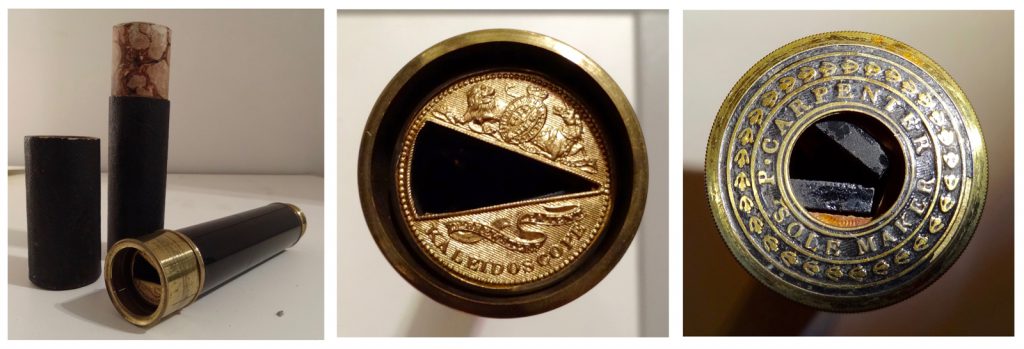
The standard kaleidoscope, with object cells, follows this design very closely, as we can see from an example in the Science Museum (see Figure 5). This instrument bears a Carpenter & Westley stamp, indicating that it is from after 1837, when the late Philip Carpenter’s business was renamed, having succeeded to his sister Mary and foreman William Westley (Carpenter, 1878, pp 7–8). It comes with a mahogany display box and various object cells, but is otherwise similar to the 1817 Kaleidoscope. What is interesting here is that the instrument has been collected into a tidy package for consumer retail. The box is velvet lined and comes with a lock and key. The kaleidoscope itself has been finished with silver plating. All of these touches are superfluous to the functioning of the instrument, but serve to add prestige value to the overall package. Brewster’s published writings on the kaleidoscope take great care to explain the scientific merits and practical application of his invention, but the instrument itself screams of luxury consumption.
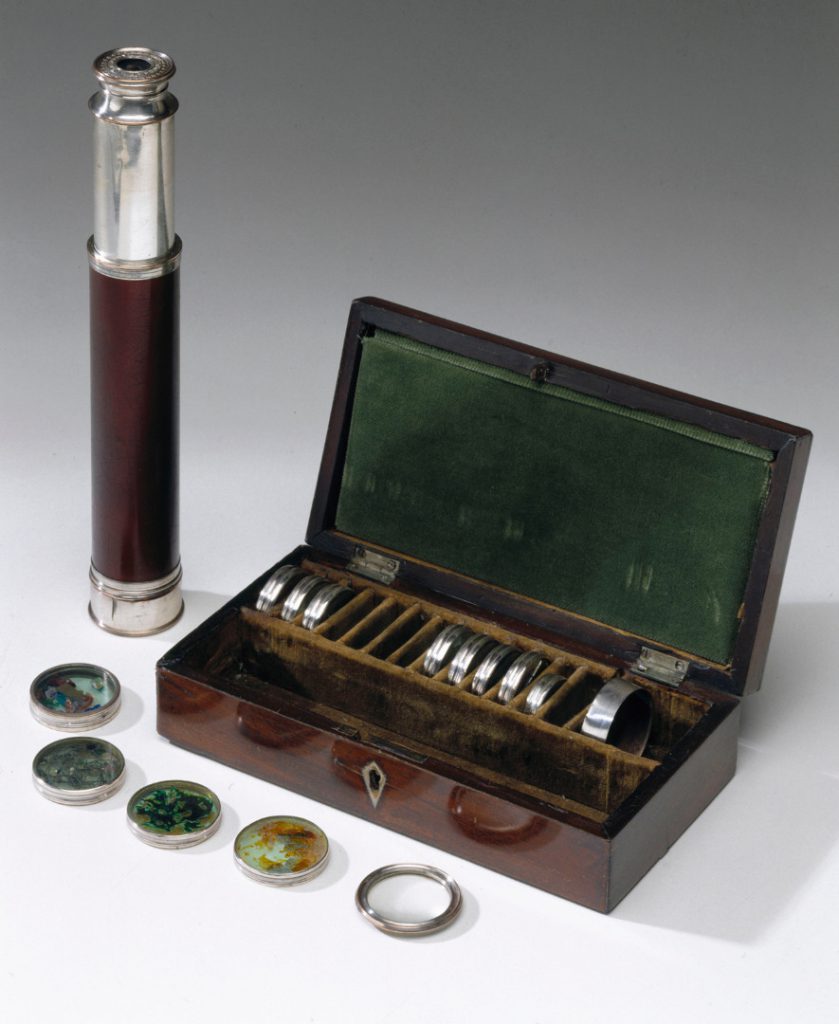
It is doubtful if the kaleidoscope was ever much appreciated as a scientific device, or that most users would have tried to understand the principles of its operation, as Brewster suggested they should do in his treatise. One commentator said that ‘no invention, perhaps, ever excited more general attention among all classes of people, than the Kaleidoscope’; but also that it ‘serves more as a toy than to any serious purpose’ (‘The Most Important Inventions and Discoveries of our Times’, 1819, p 19). Elsewhere, The Literary Panorama presents a curious gentleman captivated by his Kaleidoscope:
You see, sir, that beautiful star in the centre; that graceful red line down the middle which closely resembles the order of—Then such mountains of gold and silver! there, sir, hold it in that direction, while I just turn the—O! how beautiful! what a happy combination! all the hues of the rainbow! and pray look round the edges; what a delightful series of—yes, sir this is the true—the patent—the invaluable Kaleidoscope!
‘Political Periscope’, 1818, p 503
Here, the instrument is not discussed in terms of its practical scientific uses, as in Brewster’s treatise, but as a source of fleeting spectacle. The article goes on to utilise the kaleidoscope as an instrument of deception, reflecting the outside world as illusory abstract beauty. As Erkki Huhtamo (2014) and Nicole Garrod Bush (2015) have both shown, there are many discursive and literary articulations of kaleidoscopism that are concerned with the instrument’s beauty or deceptiveness, but very few dealing with its contribution to optical science. The Kaleidoscope’s popularity was a result of its pleasing spectacles; its scientific content was presented as a supplementary appeal to educational or practical value, so as to render it respectable.
But this was no empty spectacle. As Huhtamo argues, the Kaleidoscope allowed users to manipulate the concrete world and explore perception in ways rarely possible before. This likely also contributed to popular consumption of the microscope and telescope, which similarly played with the practice of visibility. That the Kaleidoscope was relatively cheap (for a middle-class purchaser) and widely counterfeited (Morrison-Low, 2007, pp 224–225; Correia, 2016, pp 3–4) device contributed to its success, making it the first popular optical media instrument. It offered a new way of interacting with the world. As Helen Groth shows, its spectacle presented a new form of visual transformation (2007).
Brewster claims that 200,000 Kaleidoscopes (both Patent Kaleidoscopes and counterfeit copies) were sold in three months (1819, p 7). It is impossible to verify this number, but the extensive critical furore over the device (Bush 2015) does show that it was a great success. The Philosophical Magazine said the instrument was ‘now in the hands of almost every person’ (1818, p 376). By 1818, Carpenter could no longer meet production demands and several other manufacturers were granted permission to produce the device. An 1818 advert (see Figure 6) shows that Kaleidoscopes were now manufactured by seventeen instrument makers including Carpenter, the Dollands, W&S Jones, R B Bate and John Ruthven. The majority of these new manufacturers were situated in London, but the contracting of manufacturers in Edinburgh, Liverpool and Bristol (and retaining Carpenter in Birmingham) gives some indication of the instrument’s popular appeal across the country.
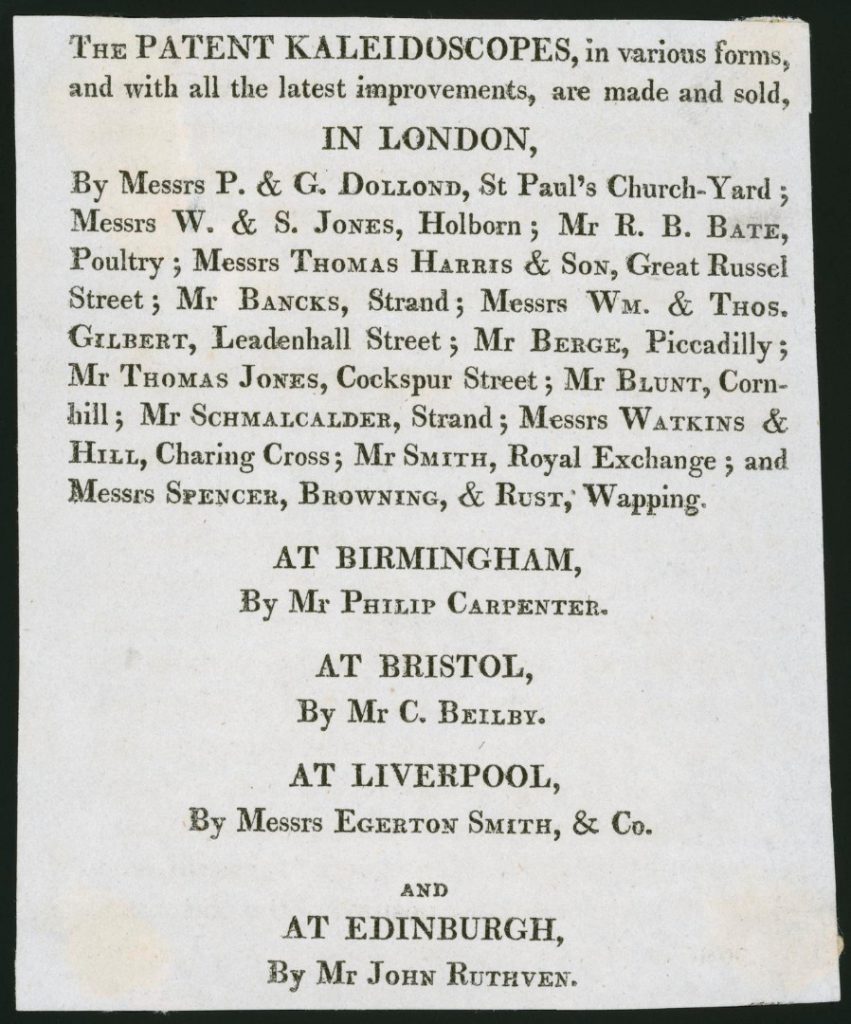
Industrial organisation
https://dx.doi.org/10.15180/170707/004It is not clear how Carpenter attained the Kaleidoscope production contract. Brewster is known to have had connections with a number of significant instrument makers in Edinburgh and London (Taylor, 1966, p 357), but Carpenter was a Birmingham optician. It is most likely that he was accepted as manufacturer because of his integration into the Birmingham workshop economy. Little is known of his pre-1817 manufacturing practice. We know that he was a practicing optician on Inge Street by 1808 and that he moved to a manufactory on Bath Row in 1813 (Roberts, 2016a, p 10). Several historians claim that he was a leading supplier of lenses and telescopes to the instrument trade (Talbot, 2006), p 17; Timmins, 1866, p 534; Morrison-Low, 2007, p 225; (Davidson, 2011), p 13), but it is unclear how they know this. We gain some sense of the size of Carpenter’s workshop from surviving documents. An 1813 leasehold document shows that he acquired 1,041 square feet of land for building (MS 3375/407007). This is a reasonable sized property, but as a later mortgage document shows, it included a dwelling house and outbuildings, as well as the manufactory building (MS 3375/407009). This means that Carpenter worked from a relatively small workshop, large enough for lens grinding and assembly work, but certainly not for brass moulding or metalwork. It also means that he worked as a wholesale optician and not yet as a retailer himself. Carpenter did not acquire his shop on New Street until at least 1819 (QS/76/3; Wrightson’s Directory, 1823, p 27). There is no way of knowing the extent of Carpenter’s early manufacturing practice, but it is reasonable to expect that he was competent and reasonably successful already, given that he was capable of attaining Brewster’s Kaleidoscope contract and that he produced enough Kaleidoscopes to provoke a popular media craze (although not enough to continue as sole maker after 1818).
Examination shows that the Kaleidoscope was assembled from multiple serially-produced parts. Given the volume of Kaleidoscopes produced, this would have required an efficient production system in line with the usual Birmingham subcontracting networks. In the early nineteenth century, Birmingham was one of the biggest manufacturing cities in the world. It had not mechanised, as had key industries in the northwest of England, because it had developed a highly-efficient network of workshops that individually manufactured small items (such as buckles and buttons), individual parts (such as gun parts and screws) and metals (principally tin, iron and brass) (Hopkins, 1989, pp 60–61). This manufacturing economy functioned through the putting-out system, where many different workshops would participate in the production of parts, to be bought and assembled elsewhere (Berg, 1991; 1993). The Birmingham trade was organised around individual workshops that each focused on a few specific tasks and outputs. Berg describes this as ‘a workshop economy built on specialisation and the division of labour, on dispersed units concentrated in specific locations and on close networking among these units’ (1993, pp 20–21). Subcontracting was common, as it was elsewhere, but without the drive towards increased capital and large, one-site manufacture. The instrument trade was small in comparison with other industries. There were few appreciable benefits to be had by mechanised production, or the production of industrial quantities of goods, because it had already attainted a high degree of efficiency through the use of hand-technologies and workshop organisation. There had previously been little need to produce instruments in bulk, but the Kaleidoscope was a different kind of enterprise.
Due to its broad non-specialist appeal the Kaleidoscope could claim a larger market than was typical of other instruments. By exploiting the rapidly expanding manufacturing networks of early-nineteenth century Birmingham, Carpenter could produce a greater volume of instruments than previously possible. The instrument workshops themselves did not require an industrial base, but through efficient subcontracting they could make use of industrial expansion in the metalwork and toy trades.
As an optician, Carpenter would surely have been a skilled lens grinder, but it is doubtful that he would have had the means to produce the tin cases, brass tubes and wooden boxes required for his instruments. Indeed, there would have been no need for him to do so, as the local workshop economy could have provided ample tinsmiths, brass founders and box makers to supply his own manufactory. Given Carpenter’s location, it is highly likely that his manufacturing practice was fully integrated into the putting-out system. His own workshop would have most likely contributed only lenses, assembly and finishing (engraving, polishing, painting, packing, etc.).
This explains the design of the early kaleidoscopes. Dismantling the Carpenter Kaleidoscope shows that its body is constructed out of two brass tubes and circular brass fixings. The brass tubes used for scientific instruments were made by drawing sheet brass through a mould under considerable pressure (2006, pp 178–183; Barclay, 1993). The Kaleidoscope required two tubes of slightly different width (so one could slide into the other), plus several moulded and cut fixings to hold the tubes together. The Commercial Directory for 1818 lists 82 brass founders and 19 brass workers. John Benton of Livery Street specialised in making ‘plated and brass tubes of every description’ (Commercial Directory, 1818, p 62; Wrightson’s Directory, 1818, p 12), which strongly suggests that he acted as a subcontractor to the instrument trade. He was part of an existing network of specialists who could have moulded and cut brass tubes for many of Carpenter’s instruments. With this in mind, it is likely that Carpenter would have made use of this established manufacturing network. The ends of the Kaleidoscope were pressed in the same process used for button manufacture (Morrison-Low, 2007, p 225), which was a key part of the Birmingham toy trade. This was simply achieved by stamping a supple disk of brass with a maker’s mark. That these practices were embedded in the surrounding workshop economy is indicated by Brewster’s own complaints that ‘tinmen and the glazers began to manufacture the detached parts of [the Kaleidoscope], in order to evade the patent’ (Brewster, 1830, p 410). Professional artisans were capable of pirating the instrument because it was designed with their existing skills in mind.
The instrument would then require assembly and would need to be fitted with mirrors and a lens (for the telescopic version) or object cells. This would likely have been done in Carpenter’s workshop as there were no cognate skills available in surrounding workshops. A local Japanner would have applied an enamel covering to the outer tube and Carpenter would then have polished and boxed the finished instrument (in a cardboard tube or wooden box bought in from elsewhere).
All of Carpenter’s instruments would likely have been integrated into the surrounding workshop economy in this way. Indeed, this was true of most instrument makers. Even among the most gifted manufacturers there is no need to duplicate skills provided by other trades. The core skills of the optician or mathematical instrument maker would also have required access to certain key materials, thus integrating their workshop into a broader network of industrial practitioners. What is interesting about the Kaleidoscope is that it was one of the first instruments to exploit the expanding industrial base in the early-nineteenth century. Through efficient design choices Carpenter could utilise the greater production capabilities of the Birmingham workshops to produce a far larger volume of instruments than was typical. The Kaleidoscope appealed to popular interest in spectacle, so it had a larger potential market than other instruments. That the manufacturing contract had to be extended to sixteen other makers only a year later shows that neither Brewster nor Carpenter fully anticipated just how successful the Kaleidoscope craze could become.
The Improved Phantasmagoria Lantern
https://dx.doi.org/10.15180/170707/005In 1821 Carpenter repeated this approach with the Improved Phantasmagoria Lantern (see Figure 7). This was a version of the magic lantern, an early slide projector that had been in use from 1659 and that had been a popular tool of travelling entertainers throughout the eighteenth century (Rossell, 2008, pp 102–140; Gonin, 2010). Because of its status as an itinerant’s tool and frivolous curiosity, the lantern had a decidedly low reputation among the respectable classes by the turn of the nineteenth century (Rossell, 2008, pp 71–73). Carpenter would use the practices developed for the Kaleidoscope in new approach to marketing magic lanterns. His business focused on the affluent middle classes, so he would have to reorient the relatively disreputable lantern so as to be acceptable to this clientele. Carpenter responded to this problem by selling the lantern as a desirable consumer object and by associating it with education.
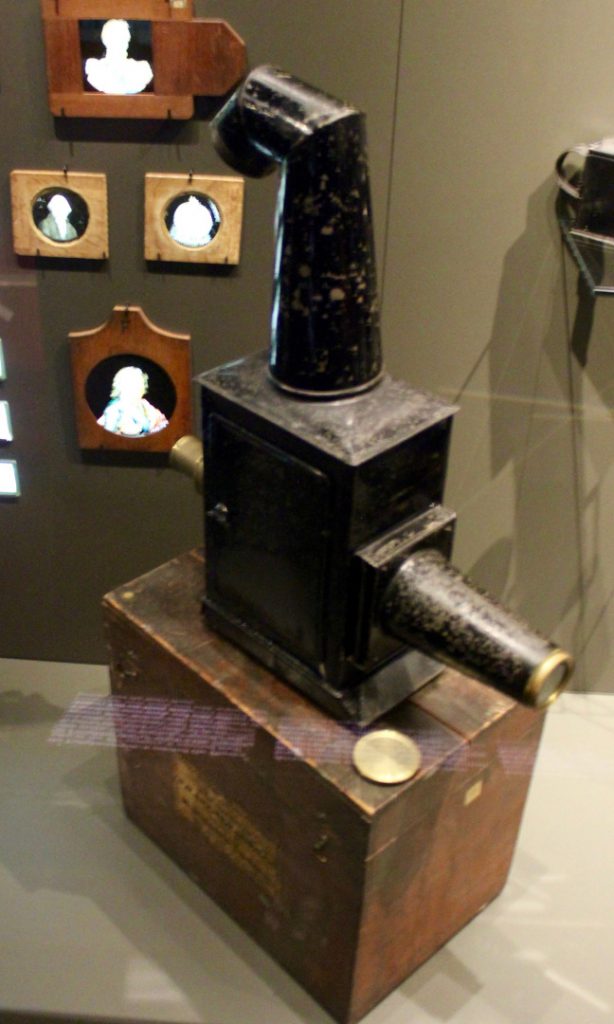
However, this impulse towards respectability intersected with another key marketing drive to present the lantern (and his other instruments) as exciting and desirable objects. To appeal to the domestic market, instrument makers would have to inject their instruments with a sense of pleasure. But they would have to tread a fine line between respectability and wonderment. Carpenter could not afford his lanterns to be perceived as dubious trick machines, nor his microscopes as boring academic instruments. His instruments had to be reputable in order to fit the tastes of his target demographic, so his marketing materials emphasise their educational and scientific nature. But it was equally important that the scientific world that they revealed, through lantern slides or microscopic objects, was wondrous. We have already seen how the Kaleidoscope negotiated this relationship.
Carpenter’s manufacturing methods were in line with the rest of the local apparatus trade, but he attained a more efficient and cost-effective set of practices through key product and marketing innovations. Timmins says that Carpenter commenced business ‘in a more systematic manner than had been known before’ (1866, p 534). We know that he was using the local workshop economy to efficiently produce large numbers of lanterns and slides. Hecht argues that ‘Carpenter was the first to go about the production of lanterns and slides in a creative, business-like fashion, finding solutions to problems that had been dormant for years’ (1993, p 77). As with the Kaleidoscope, other instrument makers followed and produced Phantasmagoria Lanterns of their own. The 1820s is the point where instrument makers started to understand the potential value of the entertainment market and so we begin to see increased numbers of non-scientific media instruments. This kind of lantern was one of the most popular instruments of the era.
The Improved Phantasmagoria Lantern was marketed as a consumer object with an established name. Carpenter took the name from the famous Phantasmagoria exhibitions, popular first in Paris from 1792, and then in London around 1800 (Heard, 2006). Carpenter adopted the name but not the format of his new lantern from the Phantasmagoria. As John Barnes says: ‘the name “Phantasmagoria” which Carpenter gave to his magic lantern was really a misnomer, for the word signifies a mode of projection rather than a type of lantern’ (1997, p 20). Carpenter’s lantern had a handle, so it was possible to use it as a supplementary lantern in a Phantasmagoria show, moving it around behind a screen to produce moving phantom projections – the companion booklets include instructions for this (Carpenter and Wesley, 1850, pp 60–62) – but it was not suitable to give Phantasmagoria shows unaccompanied. This means, contrary to Carpenter’s sales pitch, that the lantern was not ‘particularly well adapted to the exhibition of the Phantasmagoria’ (1823, p 3), at least not in the established large-scale multi-lantern format exhibited by Robertson and others. Rather, it could be used to present a smaller scale (domestic or small exhibition) Phantasmagoria show with a single lantern (see Figure 8). Despite this, as Beattie argues, Carpenter placed the Phantasmagoria Lantern in a historic context that made it easily recognisable (2013, p 7). He also added the additional term ‘Improved’, which was commonly appended to microscopes by instrument makers.
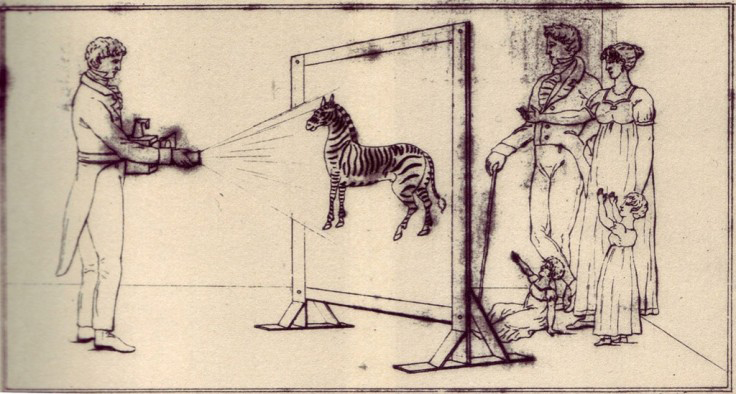
Carpenter’s lantern was made of tin, with a tall chimney that angled part way up, to protect its argand lamp from draft and to stop light escaping. It had a (sometimes adjustable) lens tube, with double condenser and objective lenses, and a diaphragm to prevent spherical aberration (Barnes, 1997, pp 19–20; Carpenter and Westley, 1850, pp 56–65). It was a significant improvement on earlier models because of the clarity of images produced (due to the arrangement and quality of its lenses), its overall simplicity and cheapness of manufacture. The most common lanterns had tended to use a single-lens bulls eye arrangement rather than the double-convex arrangement of Carpenter’s design (Carpenter and Wesley, 1850, p 56) and were more difficult to focus. The simplicity of use meant that Carpenter could target a non-professional clientele and prompt amateur users (teachers, preachers, gentlemen scientists, etc.) to take up the lantern as a useful way of presenting images in public.
Despite Carpenter’s own claims to invention, it was the manufacturing and retail strategies he implemented that constituted his most important innovations. The Lantern was integrated into the local workshop economy in the same way as the Kaleidoscope, with the required tin, brass and glass manufacture being completed by differently skilled professionals (Roberts, 2016b: 235–329). Similarly, the Copper-Plate Sliders would have required professional woodworkers, artists and engravers. Catalogues and price lists show that the Lantern could be purchased as a package that included a set of slides, a companion booklet, argand lamp, box and (in some instances) a projection microscope attachment; priced (in 1827) at £4 4s for equipment, plus 4s 6d for slides and 1s for the accompanying booklet (£4 9s 6d for everything; Carpenter, 1827, p 26). A more expensive package provided a microscope attachment and mounted object slides, ‘for exhibiting objects on a screen in the manner of a solar microscope (for £2 8s; see Figure 9). These packages provided all that was needed for an interested amateur to begin lecturing on natural history (or telling amusing stories about animals). As price lists show, it was possible to purchase some items separately (although individual slides were not sold apart from their sets, nor were argand lamps and microscope attachments separately advertised), but it is clear from advertisements and catalogues that Carpenter conceived of them as a package. The Companion to the Microcosm describes the Copper-Plate Sliders as ‘exhibited by means of the Improved Magic Lantern’ (Carpenter, 1827, p 26); that is, not by means of just any lantern, but only the Philip Carpenter-branded Improved Phantasmagoria Lantern. That the sliders were all of a standard size that fit the accompanying lanterns, at the expense of the variously-sized contemporary slides, gives an indication of Carpenter’s approach to hardware and software exclusivity.
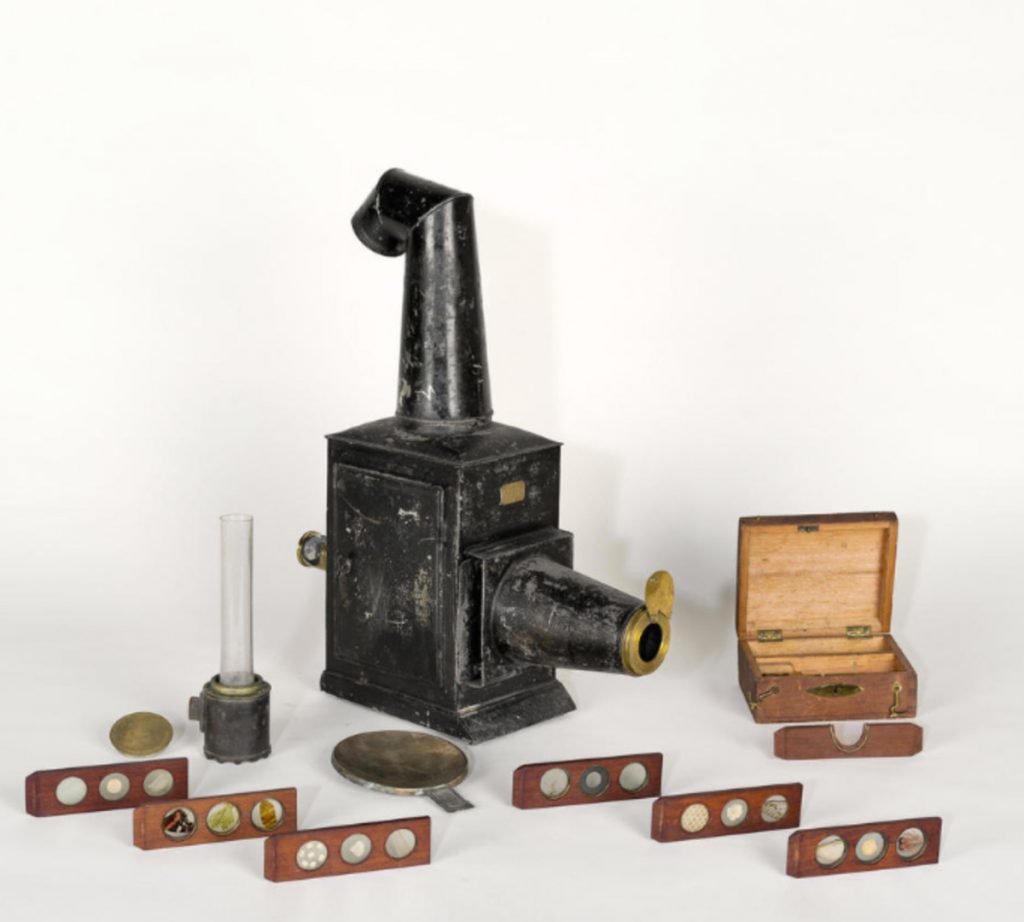
The range of slide subjects expanded quickly. In 1822 Carpenter was advertising ‘Natural History, &c.’ (certainly the Mammalia set, likely also the birds, amphibia, fish, insects and worms from Elements of Zoology, see Figures 10–16), ‘Ancient and Modern Costumes, subjects in Natural History, Portraits of Kings and Queens of England, Microscopic Objects as they Appear in the Solar Microscope, Public Buildings and Views’ (see Figures 17–18), ‘Astronomical Diagrams’ (see Figures 19–20), and ‘Humorous Subjects’ (Liverpool Mercury, 1822, p 327). With the exception of the microscopic objects, all were still available in Carpenter and Westley’s 1850 catalogue, with the only other available sets of Copper-Plate Sliders being the scripture subjects (see Figures 21–22) and botanical illustrations (1850, p 13). This shows that the range of subjects was established very early. The longevity of these sets also suggests their popularity. Carpenter and Westley later introduced similar companion guides to some of the other sets, showing that the company maintained the integrity of Philip Carpenter’s holistic approach after his death, most likely due to its success.

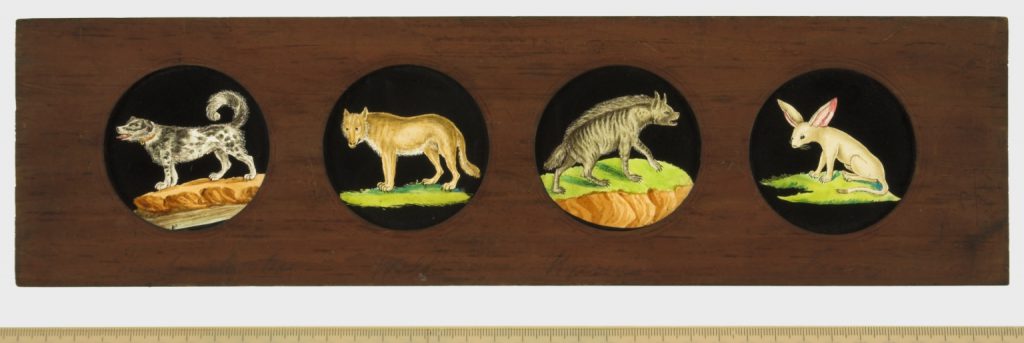







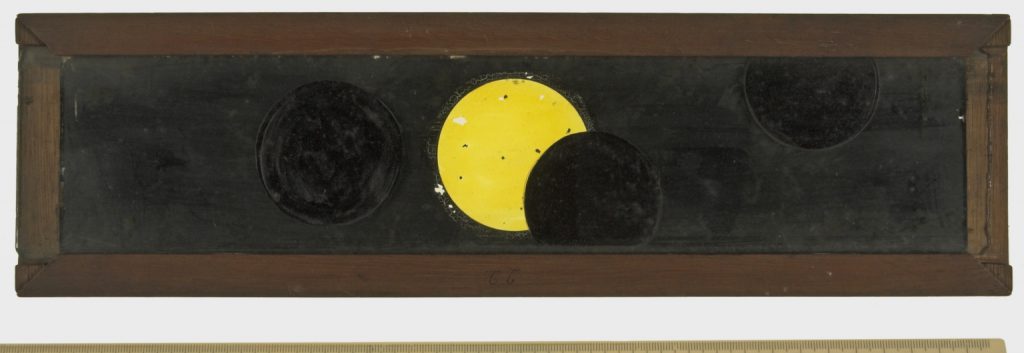
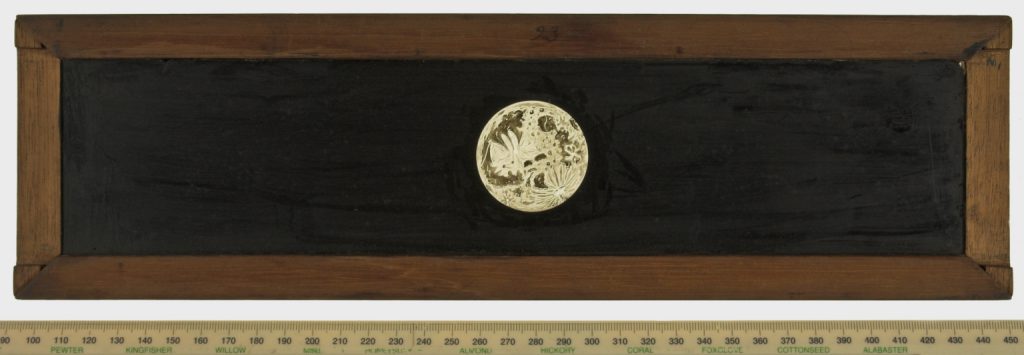


The Copper-Plate Sliders are made up of three or four transfer-printed and then hand-painted images on small glass disks, mounted in long wooden frames and secured with wire spring fixtures. These slides were the first to be printed from a single matrix (in this case a copper engraving). Carpenter’s copper-plate transfer process was based on the ceramic transfer process used by Sadler and Green from 1756 onwards (see Figure 23).

This process did not allow for full mass reproduction, as they still required quite a lot of work from painters (Roberts, 2016, pp 322–325). As Barnes argues:
It could be wrong to suppose that the outline was merely ‘coloured’ in the manner of contemporary engraved prints; instead, the skeleton impression was completely transformed into a miniature painting which varied in quality according to the skill of the artist employed, and no two pictures are ever alike.
(1984), p 9
The transfer process was not a form of mass production, but it did help Carpenter to standardise images by repeating each outline and image subject. This meant that he could sell a consistent product that could be associated with his wider marketing campaign.
The standardised images could be interpreted using the accompanying companions that gave information on each of the subjects and advice on how to present them to an audience. Elements of Zoology (1823), the first companion, situates the slides in an educational discourse and suggests that proper use of the slides requires commentary. The book’s introduction (1823, pp 5–6) situates the slide set in a broad context of learning as a means of justifying its use (and the value of natural history). It provides information on each of the different animals featured on the slides, organised into kingdoms, orders, genera and species (according to Linnaeus’ classifications). But the information provided betrays the non-scientific concerns of Carpenter’s key consumers. It is necessary for the Lantern to be seen as a reputable instrument, but it must also be exciting enough to draw sales. As a result the underlying content of the slides and their interpretive readings is entertaining rather than educational. Some extracts from the book should illustrate this:
Viverra Furo, or The Ferret. The ferret is a native of Africa, but has been tamed in Europe, and is used for rabbit hunting, and also for clearing places infested with rats. It is very susceptible to cold, and is kept in a box provided with wool. So great is its thirst for blood, that is has been known to grasp at the throats of infants in the cradle, and suck them till it has been completely gorged.
1823, p 35
Vultut Gryphus, or The Condor. This, with the exception of the ostrich, is the largest of birds, and its amazing size and strength almost realises the accounts of the Roc, in the Arabian Tales; when full grown it sometimes measures sixteen feet when the wings are extended, and is capable of snatching a small boy of ten years of age and upwards. The fulness of its plumage is such as to resist a ball fired at it from a gun.
1823, pp 76–77
Genus Testudo, or The Tortoise Tribe. This genus is divided into three assortments, land tortoises, river tortoises and sea tortoises, or turtles. They feed upon worms, the marine ones on sea weeds; when tamed they eat almost anything. They are long lived; one kept in the gardens of Lambeth attained the age of 120 years, and they are so tenacious of life, that one lived six months after its brain was taken out, walking about as before. Another lived twenty-three days after its head was cut off, and the head opened and closed its jaws for an hour after its separation from the body.
1823, p 97
These readings are more concerned with sensationalism than accuracy, and it is easy to imagine the pleasure that they may have given an audience confronted with images of the animals projected before them. We see that Carpenter has a clear understanding of the requirements for an entertaining show and that he has moulded the discursive content of his Lantern sets to meet them.
Carpenter’s business decisions were based on contextual strategies implemented to solve particular problems. His Improved Phantasmagoria Lantern and Copper-Plate Sliders package was marketed as such to stabilise a market for domestic media that could be efficiently exploited. This is his reason for focusing on educational content and marketing his sliders within the frame of respectable middle-class values, while still echoing other, ostensibly more popular, fantastic or spectacular discursive frameworks.
The Microcosm
https://dx.doi.org/10.15180/170707/006In 1826 Carpenter shifted his business to 24 Regent Street in Westminster (see Figure 24), retaining both his Bath Row workshop and New Street shop in Birmingham. He retained a presence in Birmingham for the remainder of his life, but the maker’s marks on the majority of his surviving instruments suggests that he considered Regent Street his operational base (doubtless for prestige reasons). This move came five years after he started production of the Improved Phantasmagoria Lantern and nine years after the Kaleidoscope, and shows Carpenter expanding after commercial success in the early 1820s. The Westminster rate books show that he was paying rates of £178 for the Regent Street property (1634–1900: folio 42); this shows that he had become quite affluent.
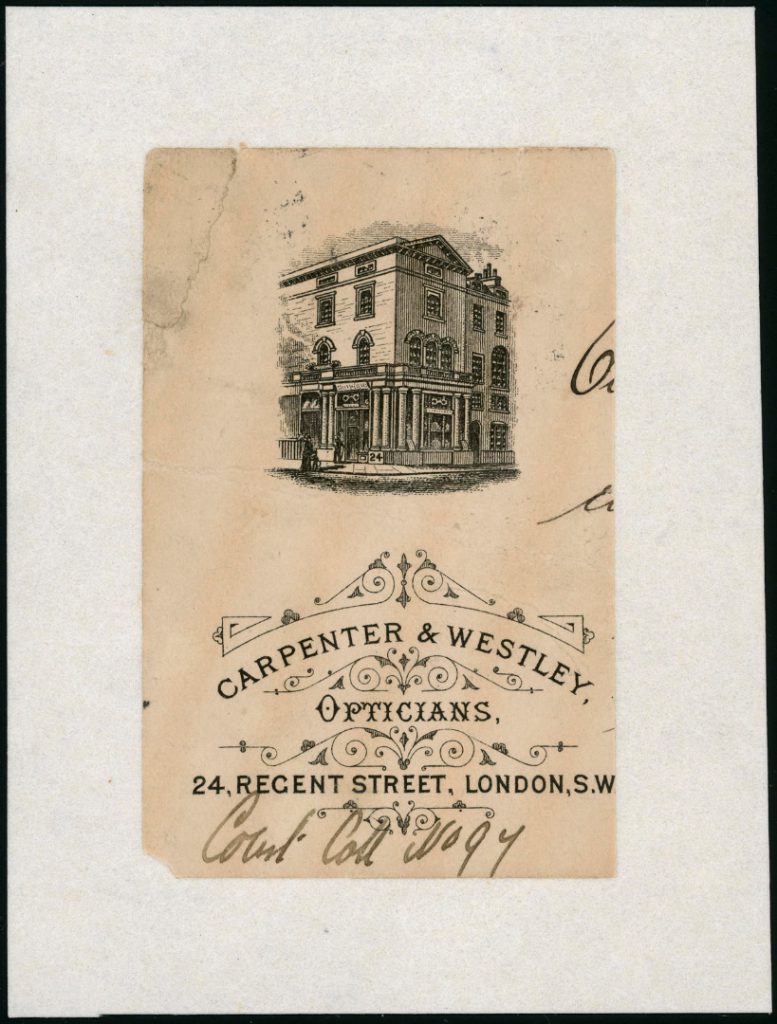
By 1826 Regent Street was the one of the centres of the consumer fashion world (Adburgham, 1979, pp 98–107). For a manufacturer like Carpenter it could act as a gateway to an increased retail market and greater prestige. It is likely that he was already shipping goods to London for sale. We know that he was sending instruments to Liverpool and Bristol (Liverpool Mercury, 1822, p 327; Morrison-Low, 2007, p 225), and that he had supplied telescopes to the Dollands of London (Timmins, 1866, p 534), using one of the many Birmingham goods carriers. Moving to Westminster made business more efficient, allowing Carpenter to sell to this market directly, without need of other instrument sellers to act as point-of-contact salespersons. As Carpenter’s fame grew, he would have received increased orders from the London market. His relocation to Westminster suggests the importance of the local consumer fashion market to his business model, and shows him taking steps to expand his potential customer base.
Regent Street provided a thriving marketplace for fashionable products and offered an excellent opportunity for Carpenter to continue to specialise in domestic media with the Phantasmagoria Lantern and expanding range of slides. But Westminster also commanded a thriving public exhibition market. Carpenter’s shop was close to popular attractions such as the Panorama, Diorama, Colosseum and Cosmorama, and entertainment venues such as the Egyptian Hall and Adelaide Gallery (Altick, 1978). These attractions were a key part of local middle-class leisure and consumption habits. Wealthy socialites would visit Regent Street to browse the numerous shops and fabric warehouses, visit a cafe, see a show, a public lecture or attend a popular attraction. Many of the entertainment venues, such as the Adelaide Gallery, were presented as scientific establishments committed to public education, but they were well-integrated into a local economy oriented towards wealthy pleasure-seekers.
In this context, Carpenter converted his shop into a public attraction in its own right, establishing ‘The Microcosm: A Grand Display of the Wonders of Nature’ (see Figure 25), an exhibition of microscopic objects and projected images installed in the shop on Regent Street between 1827 to 1835. The Microcosm exhibition was intended to encourage curious customers into the shop and to set out a frame of reference that could be transferred to Carpenter and his instruments. This exhibition was presented as scientific, but at the same time it delivered an exciting spectacle in keeping with the other (much larger) public attractions of the area. The need to sell his products (and his own reputation) to a wealthy middle-class market led Carpenter to present his marketing rhetoric in the context of a prevailing discourse on education and self-betterment. As we have seen, this context structures much of his work, but he is never entirely free from a sensationalist approach to lantern discourse. Carpenter needed to be seen as respectable and professional, but he also needed to capture the latent wonder of his instruments so as to attract popular interest. This is why the Elements of Zoology companion is so keen to establish its educational authority through reference to Linnaeus, but also why it describes bloodthirsty ferrets and tortoises living without a brain. The Microcosm also well-exploited both impulses.
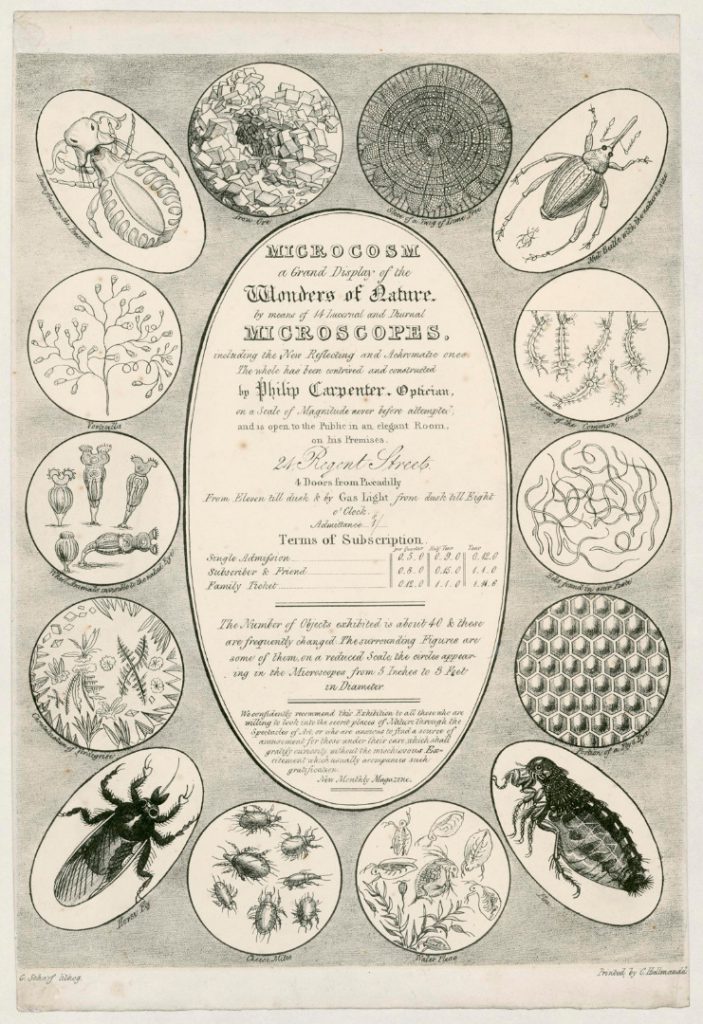
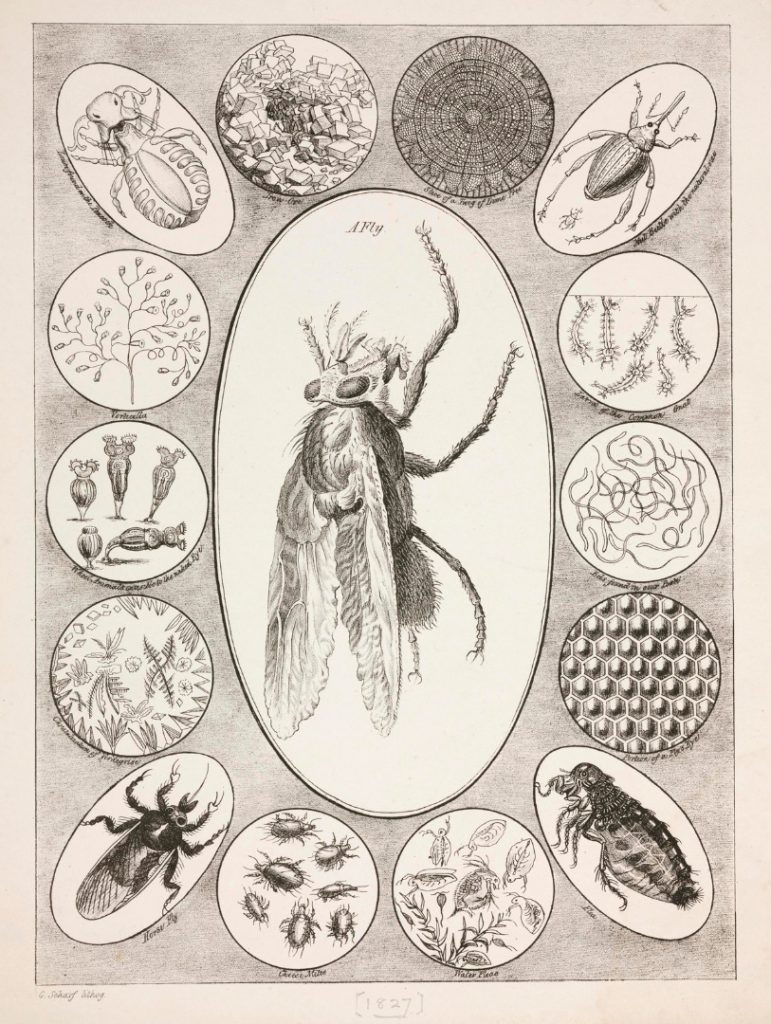
The Microcosm was initially an exhibition of microscopic views using a solar microscope (see Figures 27, 28 and 29). This was a microscope fitted up to project like a magic lantern, but illuminated by the Sun. Typically the instrument was fitted into a hole in a wall so that an external mirror could channel light towards the objectives and project an (enlarged or microscopic) image onto a wall or screen. Timmins claims that Carpenter invented the solar microscope (1866, p 534; as does Carpenter himself, (Morning Post, 1830) (‘The Microcosm’, 1827, p 24), but it had been a popular way of projecting images since the eighteenth century (Heering, 2008; Stafford and Terpak, 2001, pp 215–220). Given that limelight illumination was not commonly used until 1838 (Lambert, 1997), a well-illuminated solar microscope held a considerable advantage over the (still candle-, oil- or argand-powered) magic lantern in projection power. As with his Improved Phantasmagoria Lantern, Carpenter successfully presented an existing optical technology as a popular novelty.
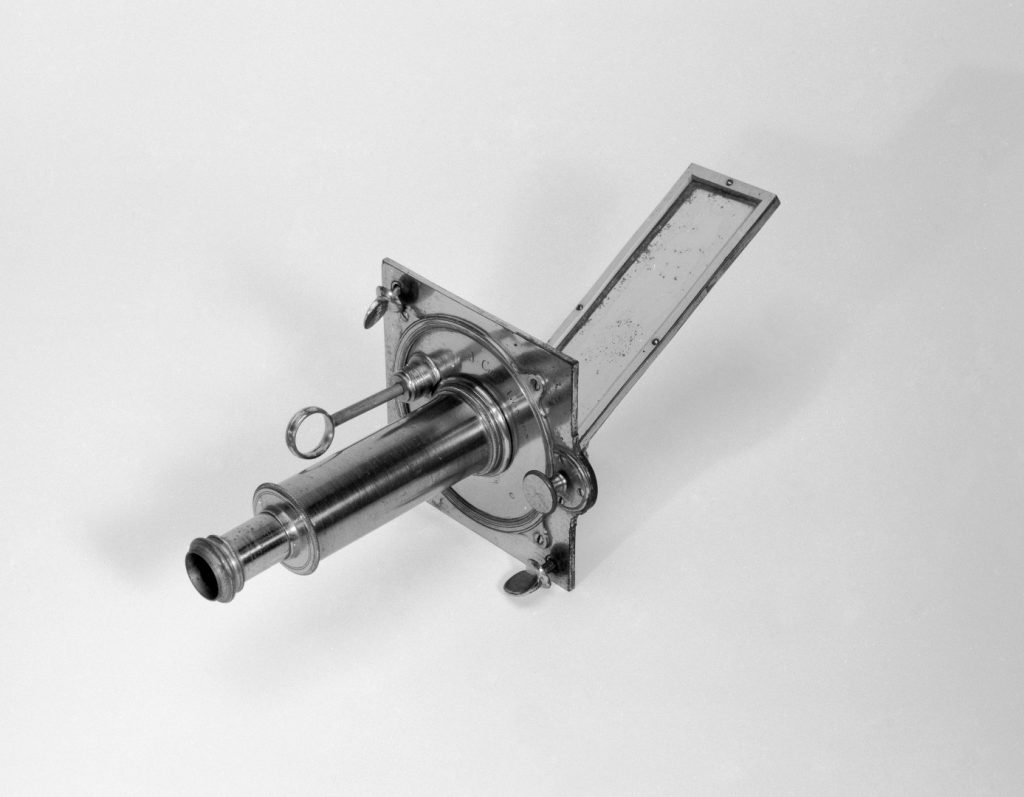
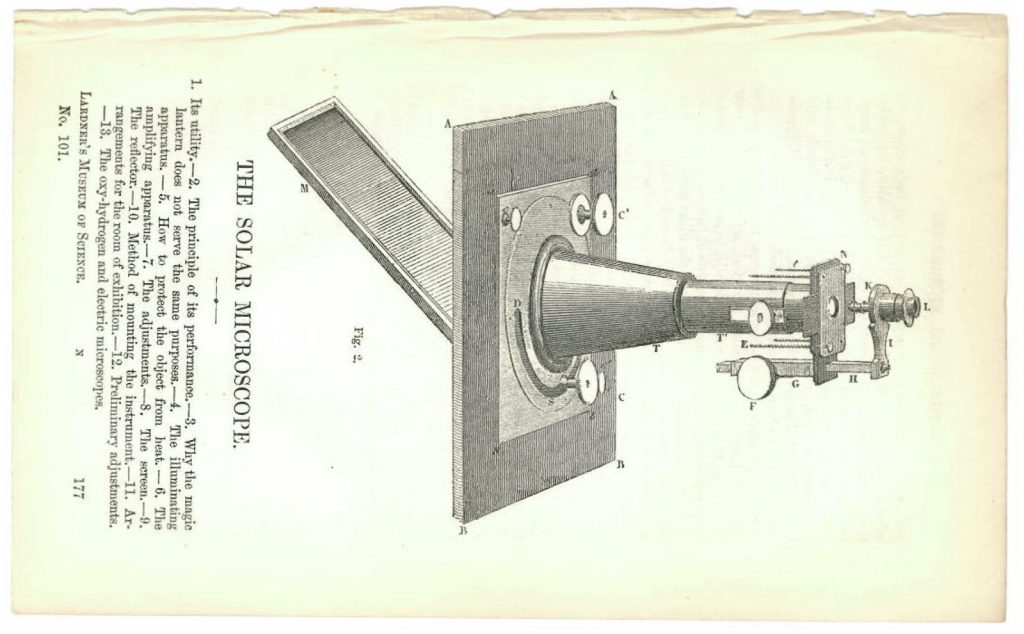
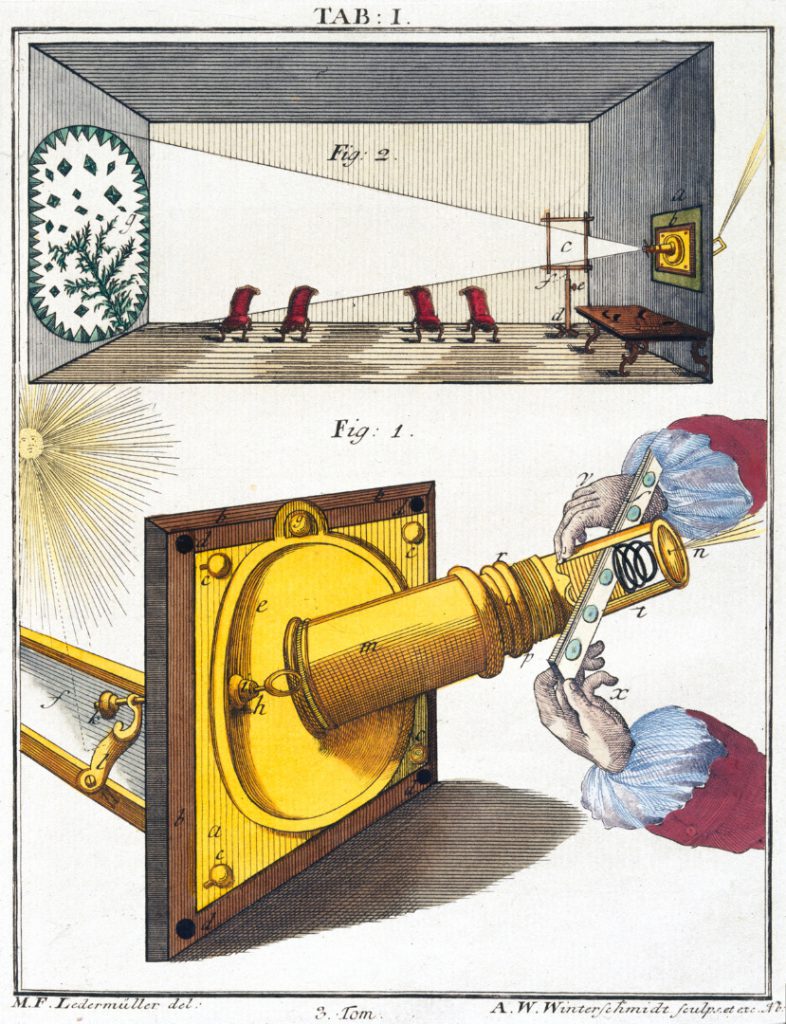
An announcement in The Morning Post in June 1827 shows that there were initially twelve microscopes, exhibiting ‘the wonders of nature on a magnitude never before attempted’ (1827). This was later expanded to fourteen, as a later advertisement shows (see Figure 25) and supported by various other effects and multiple compound microscopes. The microscopes were powered by the Sun during the day, but gas-powered after dark, giving continuous projections from eleven until eight each day. Visitors would view enlarged cheese-mites and aquatic creatures. An advert in The Morning Post says that ‘a single drop of water, filled with innumerable living creatures, occupies a space nine feet in diameter’ (1830). Carpenter again published a companion booklet that describes the different objects on view. Companion to the Microcosm lists seven transparent insects, five worms and 49 opaque objects, including beetles, earwigs, locusts, fleas, corals and lizard skin. These were varied regularly in the fourteen available microscopes.
We get an idea of what would have been seen through two lithographs in the Science Museum trade card collection (see Figures 25 and 26) and a handful of contemporary reports. Thomas Gill of The Technical Repository explains:
There are generally three sets of objects to each microscope, and these are also changed from time to time, so that novelty will never be wanting in this pleasing exhibition. The Objects are held in glazed frames, and are exposed on the outside of the house, to the full influence of daylight, and, at night, are illuminated by lamps the flames of which are reflected upon the objects by adjusting speculums. […] Among the opaque objects, the diamond curculio forms, as it ought a conspicuous one. It is exhibited entire, on a magnificent scale, and also in separate parts, still more magnified. In the transparent ones, the eels in paste are very beautifully shewn, also the cheese mites and the water fleas, all alive, and exerting their peculiar movements. Mr. Carpenter has also fitted up a large concave speculum, in a peculiar manner, so as to exhibit magnified views of larger objects, exceedingly well illuminated and defined; as, for instance, two large Indian cerambyxes, a locust, with its wings fully displayed, and a coralline.
1827, pp 342–343
Similarly, The Mirror of Literature reports that there were views of crystallised salts and coppers, insects and eggs; there were young aphides that, ‘feeding upon the juices of the leaf, […] present the appearance of a flock of sheep feeding upon an extensive plain’ (1836, p 41). Typically, commentators address the beauty or curiousness of the projections rather than any scientific content. This is to be expected given Carpenter’s integration into the local entertainment landscape around Westminster.
Further up Regent Street, the Cosmorama provided a similar display of curious views (Altick, 1978, pp 212–214; (Huhtamo, 2012), pp 40–41). The Cosmorama exhibited miniature panoramas and peephole views of famous landmarks, and while these had little scientific content, they seemed to have been similarly advertised to visitors; that is, as spectacles. Adverts in the Theatrical Observer show the Cosmorama and Microcosm advertised side by side, evidently targeted towards the same visitors (1827, p 2). As advertisement bills show, the Microcosm was later expanded to include additional curiosities that were more typical of other optical attractions. First a camera obscura was added in an adjoining room to give ‘a living picture of Regent Street’ (see Figure 30). Later still, the solar microscope was adjusted to operate by hydro-oxygen gas, so as to be brighter and unconstrained by weather conditions (see Figure 31).
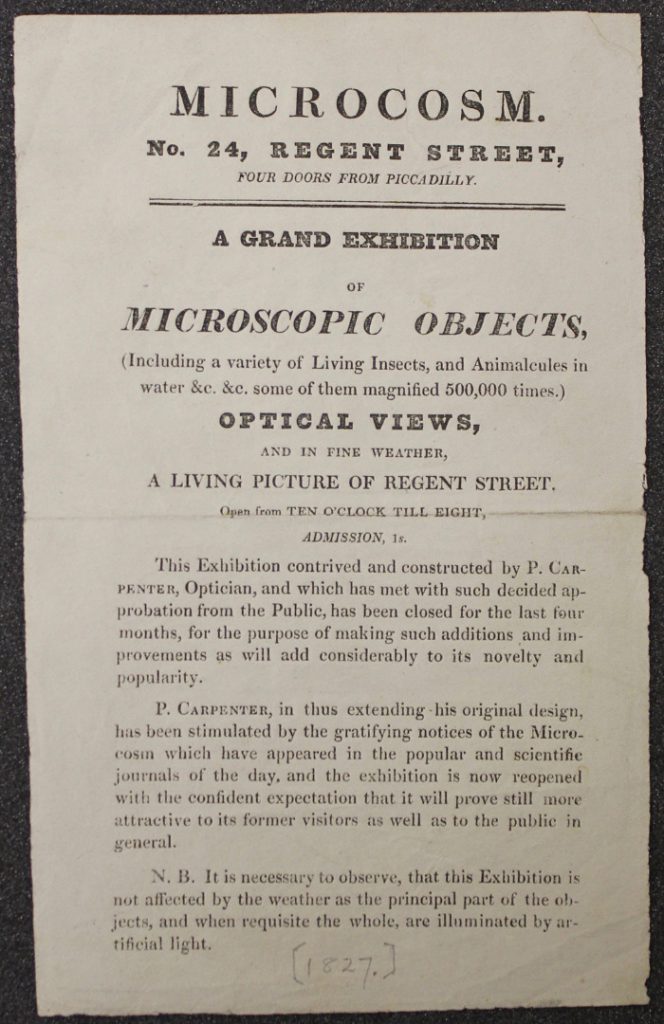
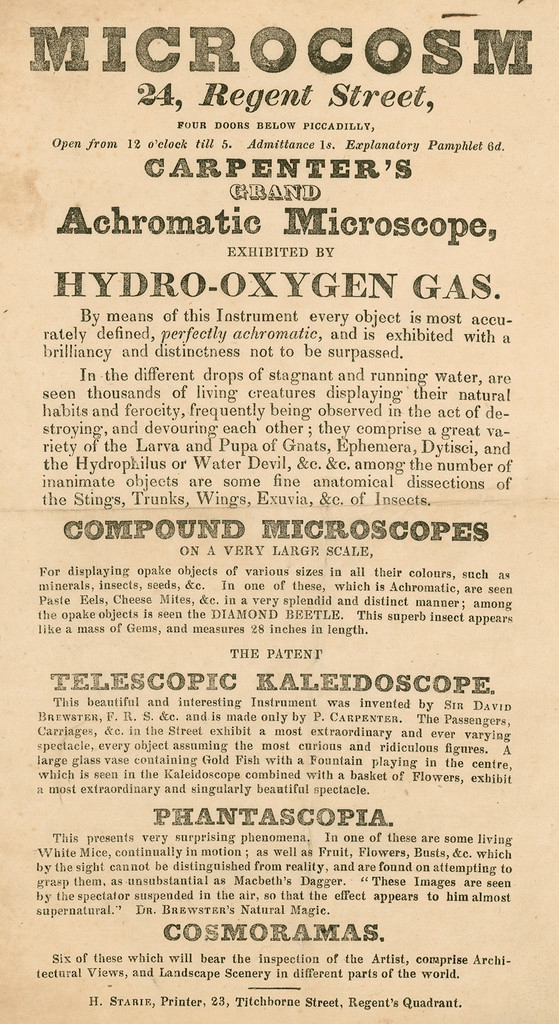
This is likely to have been sometime in the mid-to-late 1830s, after Carpenter’s death, as limelight was not commonly used in projection until then.[1] At this time six cosmoramas of architectural and landscape views were also added to rival those exhibited elsewhere, plus an attraction called the Phantascopia, an exhibition of spectral views that appeared solid, but were illusions – ‘these images are seen by the spectator suspended in the air so that the effect appears to him supernatural’. By this time, the scientific impulse had fully given way to pure spectacle. In 1828, one writer to the Theatrical Observer reported his outings to various attractions around Westminster; visiting Regent’s Park, the Egyptian Hall, the Microcosm and the Cosmorama:
At 3 I shall be found, with my spectacles off, admiring the truly grand display of the Wonders of Nature—I don’t mean the Naturals called Fops; but the Microscopic Wonders, exhibited by Mr Carpenter, the Optician, in Regent Street. Afterwards I shall look in on Mr. Finn, in the Same Street, at his Fancy Glass-working Exhibition—and pretty Work shop. […] On Friday I step into The Cosmorama, Regent Street—thirteen new Views—charming illusion, the effect of sunshine and shade astonishing;—wander through Rome, Switzerland, Valley of Lauterbroun, and take a peep at the Grand Sultan, and the Seraglio, Constantinople.
1829, p 2
The ultimate aim of the Microcosm was to pull potential customers into Carpenter’s shop. He was still a major manufacturer of spectacles and optical instruments, but his leanings were now towards the curious, middle-class market. Indeed, the importance of the popular trade to his business model is indicated by the fact that he branded his entire business as ‘The Microcosm’ in the early 1830s. A catalogue uses the moniker before the first line of his address (Carpenter, 1834) and a small microscope in the Science Museum features it as part of the maker’s mark on the inside of the box (see Figure 32). This instrument was clearly a small off-the-shelf item, but it is instructive to see evidence of Carpenter’s microscopic visions feeding into his broader instrument retail.
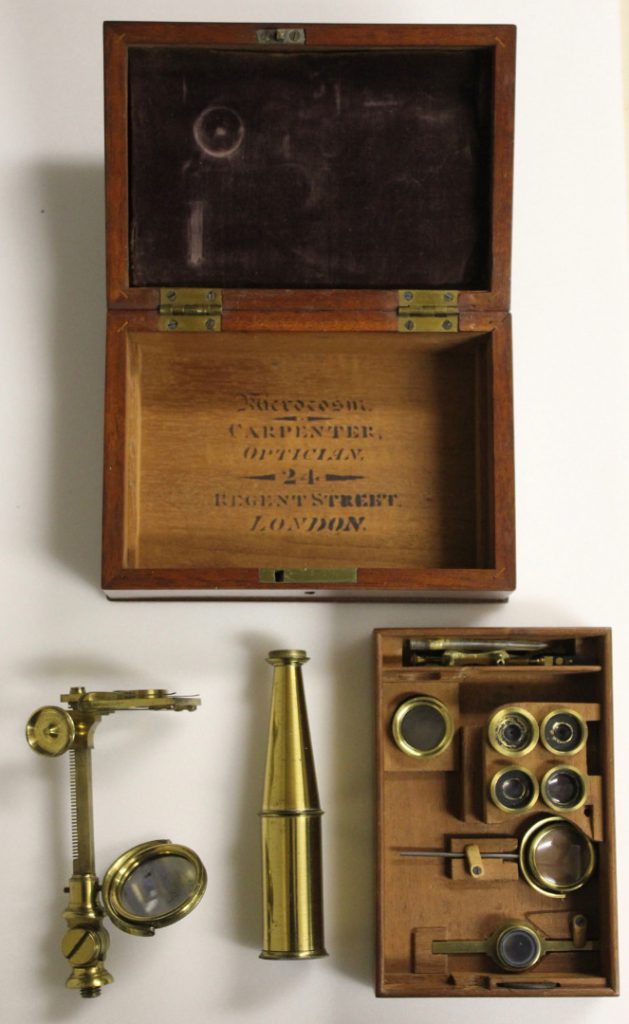
Conclusion
https://dx.doi.org/10.15180/170707/007By the 1840s certain instrument makers had diversified sufficiently to be considered a different trade entirely. These were practitioners of the optical media trade and, later, the magic lantern trade. Carpenter’s business became Carpenter & Westley in 1837, going on to become one of the major drivers of the lantern and domestic media markets. Other instrument makers such as Newton & Co. (who had been opticians and globe makers) similarly shifted into the popular entertainment market and, by the end of the century, almost completely dedicating themselves to lantern slide retail (Robinson, Herbert and Crangle, 2001, pp 209–210). These businesses were joined in the second half of the nineteenth century by other manufacturers and retailers that were not from instrument manufacturing backgrounds. Frederick York started out selling photographic equipment in 1863, but later sold stereoviews and lantern slides as York & Son (Robinson, Herbert and Crangle, 2001, pp 330–331); W C Hughes first took over a chemist’s business in 1879, later manufacturing lanterns and film equipment (Robinson, Herbert and Crangle, 2001, p 141). These later entrants into the optical entertainment market show that the trade had completely divested itself of its earlier connections with the scientific instrument trade. It had now absorbed cognate media practices from the trade in photographic equipment and chemicals, the toy trade and, at the very end of the century, the rapidly expanding trade in cinematic equipment.
The Kaleidoscope, Improved Phantasmagoria Lantern and Microcosm were key moments in the expansion of the market for popular media entertainment in the early nineteenth century and indicate how instrument makers could transform their businesses to take advantage of new commercial opportunities. Through manufacturing innovations, clever marketing and exploitation of economic changes at the beginning of the century, Carpenter was able to build a powerful presence in the public imagination as a supplier of optical entertainments. As I have shown, these were most often consumed for their appeal to novelty and wonderment, but there was also an important discourse on education and scientific value underpinning these appeals. Harking back to an older conception of science, where experimental practitioners remained close to natural magic, Carpenter understood that science already possessed an enduring kernel of wonderment and that this could be utilised as a seductive draw to curious consumers. As one reviewer put it, he sold ‘instruments to instruct and astonish at one glance’ (‘The Microcosm’, 1827, p 24). This is evident in all of Carpenter’s trade literature, which ostensibly provided information for scientific education, but betrayed a giddy excitement at the forms of the natural world. In Companion to the Microcosm Carpenter says of the Green Polyp:
The most surprising part in the history of these animals, is that when one of them is cut in two, each part soon becomes a perfect polype, or if the head is slit, each becomes a perfect head, so that by going on to slit the heads as they grow, we may form polypes with as many heads as we please. If the different portions of the polypes which have been divided be placed end to end and gently pushed together, the parts will unite, and thus polypes may be formed of the head of one and the body of the other. By pushing the polype into the mouth of another, so that their heads may be brought into contact, and kept in that situation for some time they will unite, and form one animal, and form one animal but with twice the number of arms. A polype may be turned inside out like a glove, so that the lining of its stomach becomes the outer skin, and it will live and perform all its functions as before.
1827, pp 18–19
Tags
Footnotes
Back to text


